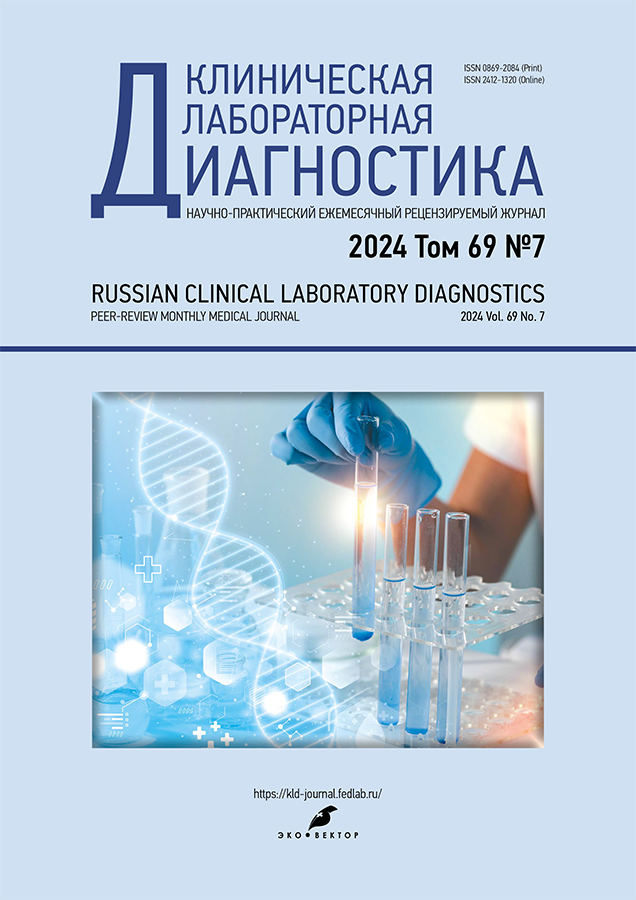Mixed infection of the tracheobronchial tree caused by the bacteria Elizabethkingia anophelis in a victim with a traumatic brain injury: etiology and diagnostic and antibacterial therapy (clinical case)
- Autores: Esaulenko N.B.1, Tkachenko O.V.1, Kazakov S.P.1,2, Chernukha M.Y.3, Gizatullin S.K.1,4
-
Afiliações:
- Main Military Clinical Hospital named after N.N. Burdenko
- Federal Research and Clinical Center of Specialized Medical Care and Medical Technologies FMBA
- N.F. Gamaleya Federal Research Centre of Epidemiology and Microbiology
- Institution of Higher Education Russian Biotechnological University
- Edição: Volume 69, Nº 7 (2024)
- Páginas: 101-110
- Seção: Clinical Case Reports
- ##submission.datePublished##: 27.08.2024
- URL: https://kld-journal.fedlab.ru/0869-2084/article/view/632353
- DOI: https://doi.org/10.17816/cld632353
- ID: 632353
Citar
Texto integral
Resumo
A clinical case of tracheobronchial tree infection caused by Elizabethkingia anophelis in a man with traumatic brain injury is presented. The pathogen is characterized by its active ubiquity and resistance to several antimicrobial drugs, including ampicillin, chloramphenicol, kanamycin, streptomycin, and tetracycline. Additionally, poly-resistant bacteria Acinetobacter baumannii and Klebsiella pneumoniae were found in the discharge of other loci. Microbiological diagnostics performed using modern bacteriological analyzers Vitek 2 Compact and Phoenix M50 with a 99 and 90% reliability, respectively, showed Elizabethkingia meningoseptica. The Autof MS 1000 mass spectrometer was used to determine Elizabethkingia anophelis, with a high confidence >9.5 of 10. The pathogen under study was found to be resistant to the main groups of antibacterial agents, but sensitive to high levofloxacin doses. The use of combined antibacterial therapy regimens using meropenem, linezolid, and levofloxacin for 7 days and additional inhalation administration of sodium colistimethate on day 15 showed a positive result with the elimination of all identified microorganisms. The study of this clinical case is beneficial in avoiding difficulties in identifying Elizabethkingia anophelis using modern bacteriological analyzers and selecting effective antibacterial therapy regimens and optimizing the duration of their administration, which thus prevents the appearance of a new hospital infection and improves the prognosis of the clinical course of the underlying disease.
Palavras-chave
Texto integral
Sobre autores
Nikolay Esaulenko
Main Military Clinical Hospital named after N.N. Burdenko
Autor responsável pela correspondência
Email: back.lab@yandex.ru
ORCID ID: 0000-0002-3514-6814
Código SPIN: 3789-2240
MD
Rússia, 3 Gospitalnaya Sq., 105094 MoscowOlga Tkachenko
Main Military Clinical Hospital named after N.N. Burdenko
Email: otkachenko84@mail.ru
ORCID ID: 0009-0003-4294-5037
MD
Rússia, 3 Gospitalnaya Sq., 105094 MoscowSergey Kazakov
Main Military Clinical Hospital named after N.N. Burdenko; Federal Research and Clinical Center of Specialized Medical Care and Medical Technologies FMBA
Email: gvkg.ckld@mail.ru
ORCID ID: 0000-0001-6528-1059
Código SPIN: 5560-3931
MD, Dr. Sci. (Medicine), Assistant Professor
Rússia, 3 Gospitalnaya Sq., 105094 Moscow; MoscowMarina Chernukha
N.F. Gamaleya Federal Research Centre of Epidemiology and Microbiology
Email: chernukha08@mail.ru
ORCID ID: 0000-0002-2349-8556
Código SPIN: 5020-3550
MD, Dr. Sci. (Medicine)
Rússia, MoscowShamil Gizatullin
Main Military Clinical Hospital named after N.N. Burdenko; Institution of Higher Education Russian Biotechnological University
Email: gizat_sha@mail.ru
ORCID ID: 0000-0002-2953-9902
Código SPIN: 2722-3355
MD, Dr. Sci. (Medicine)
Rússia, 3 Gospitalnaya Sq., 105094 Moscow; MoscowBibliografia
- Vandamme P, Bernardet JF, Segers P, Kersters K, Holmes B. NOTES: New Perspectives in the Classification of the Flavobacteria: Description of Chryseobacterium gen. nov., Bergeyella gen. nov., and Empedobacter nom. rev. Int J Syst Bacteriol. 1994,44(4):827–831. doi: 10.1099/00207713-44-4-827
- Kämpfer P, Matthews H, Glaeser SP, et al. Elizabethkingia anophelis sp. nov., isolated from the midgut of the mosquito Anopheles gambiae. Int J Syst Evol Microbiol. 2011,61(Pt 11):2670–2675. doi: 10.1099/ijs.0.026393-0
- Mallinckrodt L, Huis In 't Veld R, Rosema S, Voss A, Bathoorn E. Review on infection control strategies to minimize outbreaks of the emerging pathogen Elizabethkingia anopheles. Antimicrob Resist Infect Control. 2023,12(1):97. doi: 10.1186/s13756-023-01304-1
- Kanashenko ME, Kartsev NN, Mitsevich IP, Khramov МV, Svetoch EA. Elizabethkingia meningoseptica as a significant clinical pathogene. Bacteriology. 2019,4(1):58–63. EDN: XSCHQI doi: 10.20953/2500-1027-2019-1-58-63
- Pekkle Lam HY, Peng SY, Paramita P, et al. Biological and genomic characterization of two newly isolated Elizabethkingia anophelis bacteriophages. J Microbiol Immunol Infect. 2022,55(4):634–642. doi: 10.1016/j.jmii.2022.05.004
- Guerpillon B, Fangous MS, Le Breton E, et al. Elizabethkingia anophelis outbreak in France. Infectious Diseases Now. 2022,52(5):299–303. doi: 10.1016/j.idnow.2022.05.005
- Lin TC, Wu RX, Chiu CC, et al. The clinical and microbiological characteristics of infections in burn patients from the Formosa Fun Coast Dust Explosion. Journal of Microbiology, Immunology and Infection. 2018,51(2):267–277. doi: 10.1016/j.jmii.2016.08.019
- Xu L, Peng B, He Y, et al. Isolation of Elizabethkingia anophelis From COVID-19 Swab Kits. Front Microbiol. 2021,12:799150. doi: 10.3389/fmicb.2021.799150
- Zubova KV. The order Flavobacteriales: ecological features and clinical signifi-cance in the development of human pathology: review. Bulletin of Perm University. Biology. 2023,(1):58–64. EDN: SJVRYH doi: 10.17072/1994-9952-2023-1-58-64
- Novikova TS, Astashkin EI, Kartsev NN, et al. Asymptomatic carriage of gram-negative bacteria and antibiotic resistance genes in neuroresuscitation patients. All-Russian scientific-practical conference "Scientific support of anti-epidemic protection of the population: current problems and solutions", dedicated to the 100th anniversary of FBUN NNIIEM named after Acad. I.N. Blokhina of Rospotrebnadzor, Sep 11–12, 2019, Nizhny Novgorod. (In Russ).
- Usova EE, Averchenko YuA, Setyamina US, et al. Possibilities of MALDI-TOF identification of rare microorganisms. Clinical microbiology and antimicrobial chemotherapy. 2023,25(S1):61. (In Russ). EDN: ITMZDA
- Singh N.Sr., Singh A., Gupta P., Agarwal A. Elizabethkingia anophelis Infections: A Case Series From a Tertiary Care Hospital in Uttar Pradesh. Cureus. 2022,14(11):e32057. doi: 10.7759/cureus.32057
- Kudryashov SK, Kanishchev YuN, Putkov SB, et al. Instruction on the pre-analytical stage (order of taking, storage and transportation) with biomaterial for laboratory research in the center of clinical laboratory diagnostics of GVKG named after N.N. Burdenko. N.N. Burdenko. Kazakov SP, editor. Moscow: Eco-Press, 2016. (In Russ). EDN: YLFVVZ
Arquivos suplementares













